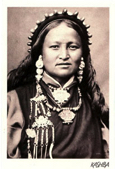Home
KASHBA Asiatica
Ais Loupatty & Ton Lankreijer
Staalstraat 6
1011 JL Amsterdam
Open 12:00 – 17:00
Zondag / Sunday 14:00 - 17:00
Contact:
31-20- 6 23 55 64

His new house rose well above the surrounding houses, but that wasn’t too hard in this old neighbourhood. One of his sons let us in while leaving the building, and subsequently sped away in a shiny new sports car.
On the top floor an elderly man was sitting in lotus position, his belly resting on crossed legs. He was turning a small mill to fan the flame of a wood fire. In a small pan he was melting dark brown wax with which he touched up – very meticulously – a small Buddha head.
He did not mind our intrusion. However, taking a picture, he brushed aside. From a corner of the otherwise empty floor I stood watching, thinking: all statue makers in this country recognize him as the absolute master.
Dalai lama, king or movie star, every new customer queued up, as a matter of course. The waiting could take years, but complaining would have little effect. Every client realised that bargaining would only backfire. His pricing was a statement.
Gradually I realized: if Newars currently create the finest Buddhist images in the world, if they themselves regard the old man on this clay floor as their absolute master, then… in any other country he would be world-famous.

The opposite seemed true more: hardly a year later I noticed in passing the little local newspaper someone was reading. My eye spotted the pale photograph amidst the Nepalese script.
- Hey, isn’t that Siddhiraj?
‘Yeah. He passed away last week.’

Why are Newar statues so often of the highest quality? After all, everywhere in the world images are made in wax, then casted and lastly patinated. With the Newar, however, the cast is only the beginning, the initial design.
Then, by deeply carving and chiseling the cast, every detail is refined and sharpened and therefore changed. Even the face, lotus, arms, attire.. big parts may get a different shape in the process.
This makes each statue a unique piece.
To differentiate in importance between cast and carving makes little sense. Only together can they produce a high quality image. Even though the proportions come from the maker of the wax model and the expressiveness out of the hands of the carver.
If necessary, the latter may improve on the original proportions.


The complicated casting process does not only constitute a profession in its own right, but is also expensive, dangerous and hectic. During the critical casting period the foundry loves to have some extra, professional hands (see: here) – and all laymen outside the gate.
Consequently, there are numerous artists who purchase casts from colleagues to work on.

The individualistic westerner usually thinks that a piece of art should be made by the artist himself. Otherwise ‘I can think of something and have it made in China as well.’
After yet another uproarious launching of a new work by Damien Hirst, the more sedate David Hockney added to his exhibition poster: ‘All art by the artist himself.’
Before long he removed line. Indeed. Who made his paint, who stretched his canvas, who made his brush or easel? Even art is a matter of collaboration. No wonder that old art often remains anonymous?



When I pass by the next day to hand over the money, the son mumbles in a slightly disgruntled tone: ‘You are getting a beautiful statue and we are getting some paper in return…’
Suddenly I get a hunch – perhaps entirely unfounded - that dear son inherits the house including the workshop and that the paterfamilias passes on this summ of money – while he still can – to dear daughter.
Once departed, I recalled having seen another Siddhiraj’ cast, somewhere in an expensive gallery on Kingsway. The statue proved still to be there and they allowed me to photograph it.

In the nineties I traded yet another end result of this specific Siddhiraj’ cast:

Consequently, I can show here three end results of the same cast next to each other. Each of the same size, of course, and chiseled by different artists in different time periods.

After all, casting and carving are different professions. It is not necessary for an artist to master both.
Last November an elderly statue maker led me to a room on a higher floor in his house to show me something. He doesn’t work much any more, his son took over the family workshop.
Traditionally they only work with brass. This alloy is easier to cast – it smoothly rolls into all cavities – but the end result is too hard and too brittle to refine any further.
The small room turns out to be furnished with great care. Immaculate – and that’s pretty remarkable. At casters’ and carvers’ there is usually a trail of metal scrap running from the workshop to the living area. On their way they seem to have forgotten what they were working on: even besides the bed you may find loose arms or Buddha heads.
A copper statue - of about one meter height - stands out in the middle of the room. As the body has been patinated darkly, the gilded face is even more striking.
I recognize it as a cast by Siddhiraj and inquire whether it is for sale as well.
He sighs and ponders for a while.
‘It must be some forty years that I have had it. All these years I kept it here, this is my own little room.’
He doubts and seems to consider many things simultaneously.
‘Obviously there comes a moment – and an opportunity – that I’d better sell it.’
All photographs and texts ©Kashba Ais Loupatty & Ton Lankreijer.Webdesign:William Loupatty

